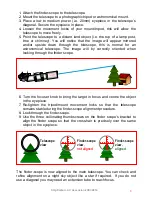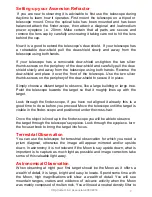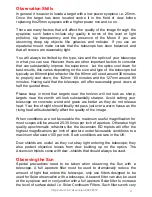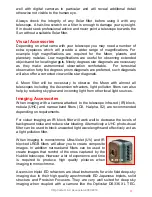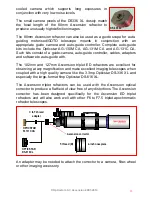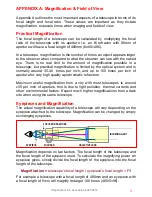
© Opticstar Ltd / Ascension 2007-2014
9
Setting-up your Ascension Refractor
If you are new to observing it is advisable to first use the telescope during
daytime to learn how it operates. First mount the telescope on a tripod or
telescope mount. Once the optical tube has been mounted and has been
balanced attach the finder-scope, then attach a diagonal and low/medium
power eyepiece i.e. 20mm. Make certain that all parts are secure and
remove the lens cap by carefully unscrewing it taking care not to hit the lens
behind the cap.
Now it is a good to
extend the telescope’s dew-shield. If your telescope has
a retractable dew-shield pull the dew-shield slowly and away from the
telescope using both hands.
If your telescope has a removable dew-shield un-tighten the two silver
thumb-screws on the periphery of the dew-shield and carefully pull the dew-
shield slowly and away from the telescope using both hands. Reverse the
dew-shield and place it over the front of the telescope. Use the two silver
thumb-screws on the periphery of the dew-shield to secure it in place.
Simply choose a distant target to observe, like a large building or large tree.
Point the telescope towards the target so that it roughly lines up with the
target.
Look through the finder-scope, if you have not aligned it already this is a
good time to do so before you proceed. Move the telescope until the target is
visible in the finder-scope and positioned under the cross-hair.
Once the object is lined up in the finder-scope you will be able to observe
the target through the telescope’s eyepiece. Look through the eyepiece, turn
the focuser knob to bring the target into focus.
Terrestrial Observation
You can use the telescope for terrestrial observation for which you need a
prism diagonal, otherwise the image will appear mirrored and/or upside
down. In astronomy it is not relevant if the Moon is say upside down, what is
important is to capture as much light as possible and image correctors take
some of this valuable light away.
Astronomical Observation
When observing at night your first target should be the Moon as it offers a
wealth of detail, it is large, bright and easy to locate. Spend some time with
the Moon, high magnifications will show a wealth of detail. You will see
mountain ranges, craters and evidence of volcanic activity when the Moon
was mainly composed of molten rock. You will need a neutral density filter to









